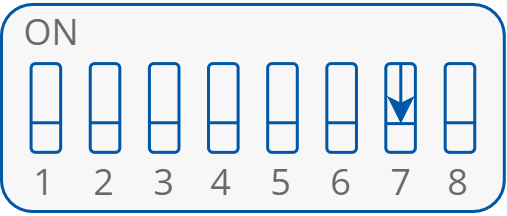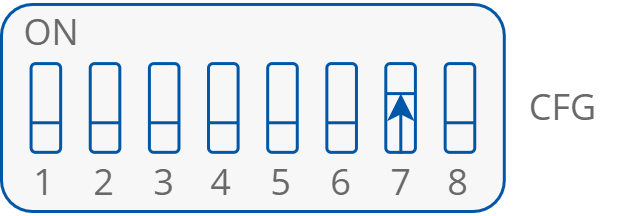The iSMA-B-2D1B device is equipped one output for controlling blind/shutter with bistable or monostable switch(es) or/and appropriate Modbus registers values.
Monostable Switch Control

Monostable switch control configuration
Monostable switches create a pulse and close the loop of the digital inputs. Monostable switches connected to the particular digital inputs, I3 and I4, send the following commands to the blind/shutter motor through the dedicated digital output(s), O3 and O4:
-
Monostable switch connected to the digital input, I3:A single short pushing the switch (< 350 ms) results in moving the slats with the value calculated with the SLATS_OPENING_TIME and SLATS_NUMBER_OF_STEPS registers.
The I3 digital input has a direct connection to the O3 digital output, which is dedicated to connecting the motor that opens the shutter.
Example:
The default value of the SLATS_NUMBER_OF_STEPS register is 10. It means that the slats move from 0% to 100% in 10 steps. In such case, each step corresponds to 10% of full range of the possible movement of the slats–the single short click of the monostable switch, by default, moves the slats by 10% of the full moving range.
The time needed for the shutter motor to move the slats from 0% to 100% is determined in the SLATS_OPENING_TIME register, and it can be changed by overwriting the register manually or automatically by slats calibration procedure. By default, the time of opening the slats is 1 second.
If the slats reach the full moving range position, a single push of the monostable switch opens the shutter (provided that the shutter is not fully open).
-
If the monostable switch is pushed longer than 350 ms (but < 2 s), it opens the shutter to the maximum open position (BLIND_STATE register = 100%). The I3 has a direct impact on the O3, dedicated for connecting the motor which opens the shutters.
The time needed for the shutter motor to move from 0% to 100 % is set in the BLIND_UP_TIME register, and it can be changed by overwriting the register manually or automatically with the shutter calibration procedure.
In addition to the BLIND_UP_TIME, the shutter is pulled up with the value stored in BLIND_OFF_DELAY register (by default, 5% of the BLIND_UP_TIME). If the BLIND_UP_TIME ends, the shutter motor runs longer by the time value calculated by the BLIND_OFF_DELAY in order to ensure that the shutter is fully open. The function was implemented because the shutter control is based on the time, but not on the position sensor.
A short single push of any switch (raising edge of the signal, connected to I3 or I4) stops the shutter and sets the slats in the position set in the SLATS_STATE register.
-
The monostable switch pushed longer than 2 seconds opens the shutter. Releasing the switch stops the movement of the shutter and sets the slats in the position set in the SLATS_STATE register. The I3 digital input has a direct impact on the O3 digital output connecting the motor, which opens the shutter.
The blind position is calculated proportionally to the time of pushing the monostable switch and BLIND_UP_TIME register value.
Example:
The switch is pushed for 5 seconds. The BLIND_UP_TIME value is 20 seconds.
In such case, the position of the blind is 15% open because the shutter starts opening after 2 seconds of pushing the monostable switch, therefore, the shutter moves 3 seconds. If the full opening time is 20 seconds, the shutter position is 3/20 = 15% open.
-
Monostable switch connected to Digital Input No. 4A single short push of the switch (< 350 ms) results in moving the slats with the value calculated by using the SLATS_OPENING_TIME and SLATS_NUMBER_OF_STEPS registers. The I4 digital input has a direct impact on the O4 digital output which connects the motor in such a way that it closes the shutter.
Example:
The default value of the SLATS_NUMBER_OF_STEPS register is 10. It means that the slats move from 100% to 0% in 10 steps. In such case, each step corresponds to 10% of full range of the possible movement of the slats–the single short click of monostable switch, by default, closes the slats in 10% of the full moving range.
The time necessary for the shutter motor to move the slats from 100% to 0% is set in the SLATS_OPENING_TIME register, and it can be changed by overwriting the register manually or automatically with the slats calibration procedure. By default, the time of closing the slats is 1 second.
If the slats reach the full moving range position, a single push of the monostable switch effects in closing the shutter (provided that the shutter is not fully closed).
-
If the monostable switch is pushed for longer than 350 ms (but < 2 s), it sets the shutter in the fully closed position (BLIND_STATUS register = 0 %). The I4 digital input has a direct impact on the O4 digital output, which connects the motor closing the shutter.
The time needed for the shutter motor to move from 100% to 0% is set in BLIND_DOWN_TIME register, and it can be changed by overwriting the register manually or automatically with the shutter calibration procedure.
In addition to the BLIND_DOWN_TIME, the shutter is pulled up with the value set in BLIND_OFF_DELAY register (by default, 5% of the BLIND_DOWN_TIME). If the BLIND_DOWN_TIME ends, the shutter motor runs longer by the time value calculated by the BLIND_OFF_DELAY in order to ensure that the shutter is fully closed. The function was implemented because the shutter control is based on the time, but not on the position sensor.
A single short push of any of the switches (raising edge of the signal, connected to I3 or I4) results in stopping the shutter and setting the slats in the position set in the SLATS_STATE register.
-
The monostable switch pushed for longer than 2 seconds closes the shutter. Releasing the switch stops the shutter and sets the slats in the position set in the SLATS_STATE register. The I4 digital input has a direct impact on the O4 digital output, which connects the motor closing the shutter.
The position of the blind is calculated proportionally to the time of pushing the monostable switch and the BLIND_DOWN_TIME register value.
Example:
The switch is pushed for 5 seconds. The BLIND_DOWN_TIME value is 19 seconds.
The shutter starts opening after 2 seconds of pushing the monostable switch, therefore, the shutter is moving for 3 seconds. In such case, provided that the full closing time is 20 seconds, the shutter position is 3/19 = 16% closed.
Bistable Switch Control

Bistable switch control configuration
Bistable switches have two stable states. Bistable switches connected to digital inputs I3 and I4 send the following commands to the blind/shutter through the dedicated digital outputs, O3 and O4:
-
BLIND UP: closed circuit on the I3 closes the circuit on the O3. The blind motor should be connected to the O3 in such a manner that the motor opens the controlled blind.
The open circuit on the I3 opens the circuit on the O3. In such case there is no movement of the blind motor. If the bistable switch changes its state during the movement of the blind motor, the controlled blind stops.
-
BLIND DOWN: closed circuit on the I4 closes the circuit on the O4. The blind motor should be connected to the O4 in such a manner that the motor closes the controlled blind.
The open circuit on the I4 opens the circuit on the O4. In such case there is no movement of the blind motor. If the bistable switch changes its state during the movement of the blind motor, the controlled blind stops.
WARNING! It is highly recommended to use the changeover bistable switches. It prevents the user from closing both digital outputs circuits at the same time and protects the motor from damage.
Note: Please note that in addition to common single bistable switches, there are 3-states bistable switches available on the market, which can be a good replacement for single bistable switches.
